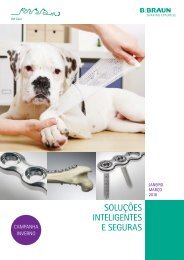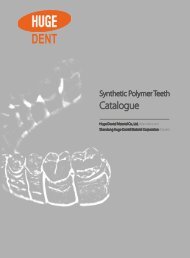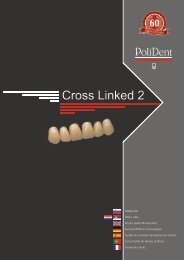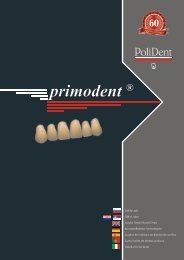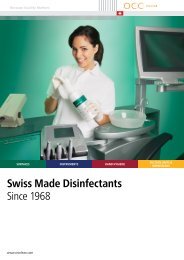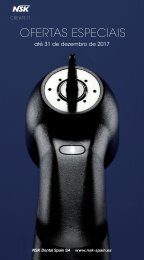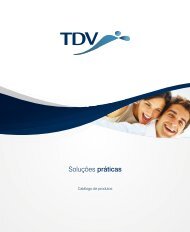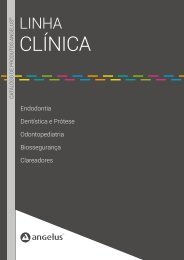Dentistry DE_US 2017 x4
You also want an ePaper? Increase the reach of your titles
YUMPU automatically turns print PDFs into web optimized ePapers that Google loves.
General recommendations for the safe use and application of dental rotary<br />
instruments (medical devices according to MDD 93/42/EC)<br />
All DFS-Diamon rotary instruments for dentist use need to be<br />
sterilized before every use on the patient. This applies as well<br />
to single-use instruments (except felts) prior to first use.<br />
Single-use instruments have to be discarded after use. Felts<br />
cannot be sterilized, see instructions for use for Diafix ®- Oral.<br />
Our instruments have been developed and designed for their<br />
specific use. Improper use can lead to damage to tissues, premature<br />
wear, destruction of the instruments and may cause<br />
danger to users, patients or third parties.<br />
Rotary instruments for use in medical applications are to be<br />
used only by doctors or other experts who are adequately<br />
skilled, trained and experienced in the safe handling of these<br />
instruments.<br />
1. Proper use<br />
• Only handpieces, turbines and contra-angles that are in<br />
perfect technical and hygienic condition may be used.<br />
• The instrument must be rotating at the appropriate speed<br />
before contact is made with the workpiece, tissue, etc.<br />
• Insert the instruments into the chuck as deeply as possible.<br />
• Avoid jamming and do not use the instrument as a lever<br />
as this increases the risk of breakage.<br />
• Wear safety goggles wherever required.<br />
• Avoid unprotected contact with the instruments, the use<br />
protective gloves is strongly recommended.<br />
• When using rotary instruments ensure sufficient cooling<br />
(except when the manufacturer recommends use without<br />
cooling).<br />
Improper use increases the risk of injury and/or damage and<br />
leads to inferior results. Therefore, please follow the application<br />
and speed recommendations as indicated on the labels.<br />
2. Recommended speeds<br />
• You will achieve the best results when observing the<br />
instrument-specific recommended speed (see product description).<br />
• Long and pointed instruments may break when the<br />
recommended speed is exceeded due the possible vibration<br />
in the tip area.<br />
• In case of instruments where the diameter of the working<br />
part exceeds the diameter of the shank strong centrifugal<br />
forces may occur if the selected speed is too high. This may<br />
result in bending of the shank and/or breakage of the<br />
instrument. The recommended maximum speed must not<br />
be exceeded.<br />
• The general rule is: the larger the working part, the lower<br />
the selected speed should be.<br />
3. Contact pressure<br />
• Excessive contact pressure must be strictly avoided.<br />
• Excessive contact pressure can cause thermal damage to<br />
the tooth or the pulp. Moreover, it may lead to undesirably<br />
rough surfaces due to broken blades.<br />
4. Cooling<br />
• In order to avoid undesirable heat generation sufficient<br />
cooling with air/water mix of min. 50ml/min needs to be<br />
provided during preparation.<br />
• When using FG instruments sufficient water cooling needs<br />
to be provided continuously.<br />
• Insufficient cooling may cause permanent damage to the<br />
tooth, surrounding tissue and/or pulp.<br />
• Coarse and extracoarse grit diamonds may lead to increased<br />
thermal stress. When using these instruments ensure<br />
sufficient cooling and work with minimal contact pressure.<br />
After using these instruments, subsequent finishing (fine<br />
diamonds or carbides) is required.<br />
5. Frequency benchmark for the application of<br />
rotary instruments<br />
The following values serve as a reference only; the actual service<br />
life may differ depending on the application, usage and<br />
material but must not exceed the maximum number of<br />
reprocessing cycles.<br />
• Diamond instruments<br />
30x<br />
• Carbide instruments<br />
20x<br />
• Instruments made of steel<br />
5x<br />
• Polishers and brushes made of nylon 10x<br />
• Ceramic instruments<br />
15x<br />
• Tissue punches<br />
15x<br />
• Felt polishers<br />
single use<br />
6. Elimination of worn instruments<br />
Blunt and damaged instruments may encourage the user to<br />
apply excessive contact pressure, which in turn generates<br />
increased operating temperatures. As this can result in permanent<br />
pulp damage, instruments showing wear, damage or<br />
which are blunt have to be discarded immediately.<br />
7. Disposal<br />
Used instruments must be discarded with general clinical<br />
waste.<br />
8. Additional remarks<br />
Please refer to the product descriptions on the respective<br />
catalog pages for more information. Instructions for use are<br />
available electronically at www.dfs-diamon.de.<br />
Rev.: 07/2016<br />
71




